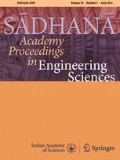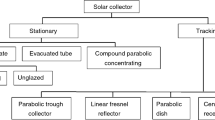Abstract
This paper presents a finite element method based three-dimensional thermal model for predicting the performance of evacuated U-tube solar collector. Numerically predicted working fluid outlet temperature is compared with the experimental data available in the literature and a good agreement is observed between them. The influence of average solar irradiance on efficiency and useful heat gain rate of the solar collector is studied for two different evacuated tube configurations. Employing water and air as working fluid, copper, aluminium and brass as U-tube material, and graphite, magnesium oxide and aluminium oxide as filler material and the performance of the evacuated tube solar collector is investigated in detail.













Similar content being viewed by others
Abbreviations
- Ac :
-
area of the collector (m2)
- cp :
-
specific heat at constant pressure (kJ/kg–K)
- kg :
-
thermal conductivity of the glass tube (W/m–K)
- kfr :
-
thermal conductivity of the filler material (W/m–K)
- ka :
-
thermal conductivity of the inner glass tube/absorber tube (W/m–K)
- kf :
-
thermal conductivity of the fin material (W/m-K)
- ku :
-
thermal conductivity of the U-tube (W/m–K)
- LHS:
-
latent heat storage
- \( \dot{\hbox{m}} \) :
-
mass flow rate (kg/s)
- P:
-
pressure (Pa)
- Quseful :
-
useful heat gained by the working fluid (W)
- T:
-
temperature (°C)
- \( \vec{v} \) :
-
velocity (m/s)
- α:
-
absorptivity of the inner glass tube/absorber tube
- λ:
-
average solar irradiance (W/m2)
- ρ:
-
density (kg/m3)
- μ:
-
dynamic viscosity of working fluid (Pa–s)
- ε:
-
emissivity of the outer glass tube
- η:
-
solar collector efficiency (%)
- σ:
-
Stephen Boltzmann constant (W/m2–K4)
- τ:
-
transmissivity of the inner glass tube/absorber tube
- amb:
-
ambient air
- ini:
-
initial
- i:
-
inner
- o:
-
outer
- w,o:
-
working fluid outlet
- w,i:
-
working fluid inlet
- wf:
-
working fluid
References
Harding G, Zhiqiang Y and Mackey D W 1985 Heat extraction efficiency of a concentric glass tubular evacuated collector. Int. J. Solar Energy 35: 71–79
Eberlein M B 1976 Analysis and Performance Predictions of Evacuated Tubular Solar Collectors using Air as the Working Fluid. University of Wisconsin
Zhiqiang Y, Harding G and Window B 1984 Water-in-glass manifolds for heat extraction from evacuated solar collector tubes. Int. J. Solar Energy 32: 223–230
Morrison G, Budihardjo I and Behnia M 2004 Water-in-glass evacuated tube solar water heaters. Int. J. Solar Energy 76: 135–140
Morrison G, Budihardjo I and Behnia M 2005 Measurement and simulation of flow rate in a water-in-glass evacuated tube solar water heater. Int. J. Solar Energy 78: 257–267
Hazami M, Naili N, Attar I and Farhat A 2013 Solar water heating systems feasibility for domestic requests in Tunisia: thermal potential and economic analysis. Int. J. Energy Convers. Manage. 76: 599–608
Nkwetta D N, Smyth M, Zacharopoulos A and Hyde T 2013 Experimental performance evaluation and comparative analyses of heat pipe and direct flow augmented solar collector. Int. J. Appl. Therm Eng. 60: 225–233
Neeraj M and Avadhesh Y 2015 Experimental analysis of thermal performance of evacuated tube solar air collector with phase change material for sunshine and off sunshine hours. Int. J. Amb. Energy 2162–8246
Badar A W, Buchholz R and Ziegler F 2011 Experimental and theoretical evaluation of the overall heat loss coefficient of vacuum tubes of a solar collector. Int. J. Solar Energy 85: 1447–1456
Gao Y, Fan R, Zhang X Y, An Y J, Wang M X, Gao Y K and Yu Y 2014 Thermal performance and parameter analysis of a U-pipe evacuated solar tube collector. Int. J. Solar Energy 107: 714–727
Naik B K, Vrashney A, Muthukumar P and Somayaji C 2015 Modelling and performance analysis of U type evacuated tube solar collector using different working fluids. Energy Procedia 90: 227–237
Ayala J A A, Rodriguez G M, Nunez M P, Ramirez A R U and Munoz A G 2015 Numerical study of a low temperature water-in-glass evacuated tube solar collector. Int. J. Energy Convers. Manage. 94: 472–481
Young H D 1992. University Physics 7th Ed. Boston, United states: Addison Wesley, pp 192–194
Author information
Authors and Affiliations
Corresponding author
Rights and permissions
About this article
Cite this article
Naik, B.K., Muthukumar, P. Performance assessment of evacuated U-tube solar collector: a numerical study. Sādhanā 44, 23 (2019). https://doi.org/10.1007/s12046-018-0974-z
Received:
Revised:
Accepted:
Published:
DOI: https://doi.org/10.1007/s12046-018-0974-z




